I found a video on Youtube about the birth of the UPC code. Notice the IBM 3663 cash registers. I first saw these registers in use at Wegmans in the mid to late 1970s.
Archives
bookmark_borderHappy Holidays!
Enjoy your last minute shopping! Here we have an NCR 2152 cash register in an unknown location. I remember several chains running with these registers in the 80s and 90s, including Sears (after the Singer-Friden registers), BonTon, and Caldor.
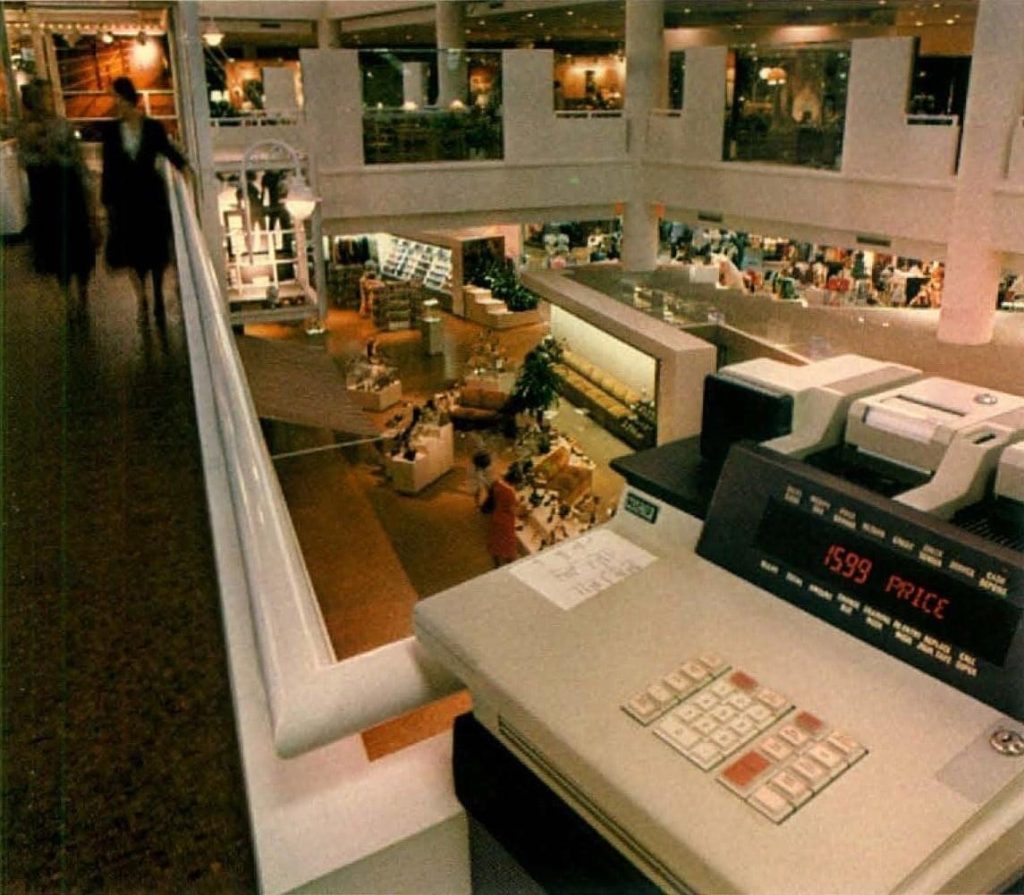
bookmark_borderData Terminal Systems.
Going through old photos I found this picture of a Data Terminal Systems Series 400 cash register in Canada. I believe there’s an old mall or shopping center that’s preserved in its legacy state, complete with three checkouts and these registers.
Anyone remember the location?

bookmark_borderKmart Canada.
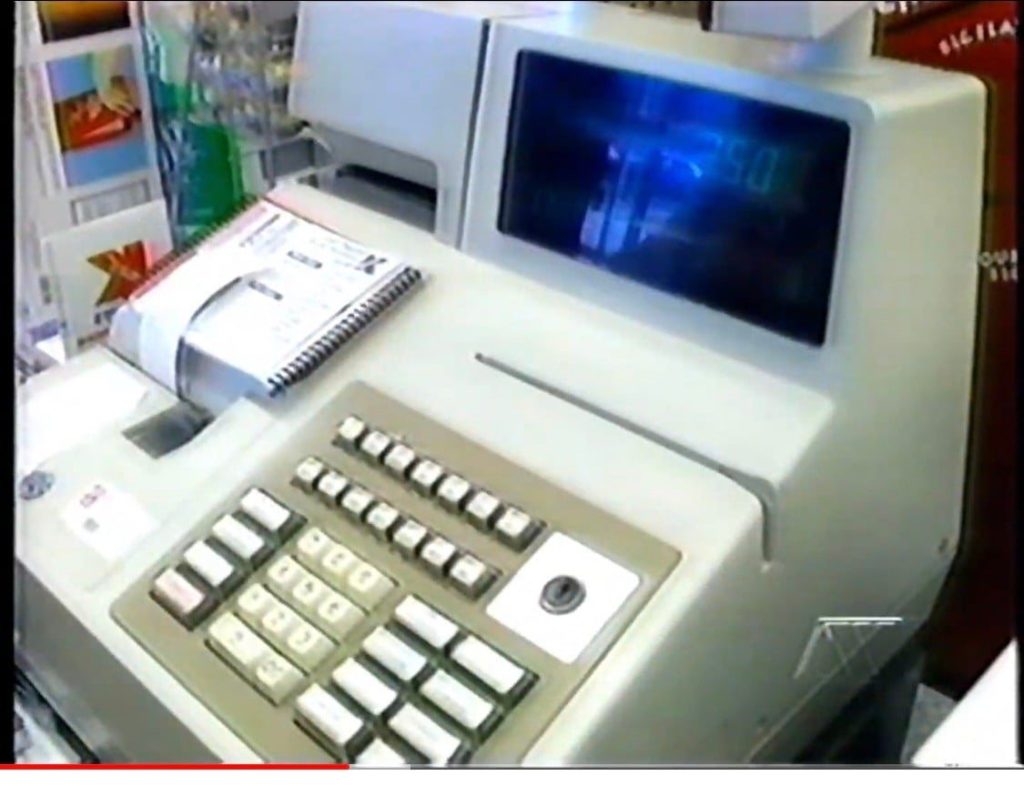
In 1965, the Singer Sewing Machine Company moved into the world of computers by purchasing the Friden Calculating Machine Company, manufacturers of calculators and other computing equipment. With the purchase of Friden, Inc., Singer Business Machines was born. The Singer System Ten, with its focus on point of sale computing equipment, was released in 1970s.
Kmart Canada took a different path than its U.S. counterpart when it came to equipment used at the checkouts. While Kmart U.S. was generally using NCR Class 5 mechanical cash registers or early electronic cash registers from NCR or Data Terminal Systems, some locations in Canada began using the Singer System Ten and Singer-Friden 908 point of sale terminals. Singer left the computing industry in 1976, selling the SBM division to International Computers Limited. ICL continue developing the Singer line, evolving the System Ten to the System 25. However, along the way, Kmart Canada moved their back-end controllers to microprocessors called the System CD 100, supplied by CyberData of Monterey, California.1
In the early to mid 1980s (still determining the date), the Singer terminals at Kmart Canada stores were undoubtedly coming to their end of useful life. While the machines could be adapted to work with just about any backend system, as these machines were designed to perform mathematical computations at the register, relying on back-end processing for inventory and account lookup information, with SBM equipment being integrated into ICL’s existing systems before the merger, Kmart Canada began looking for new registers.
It appears that Kmart Canada decided to go with the ICL 9500 series of registers.
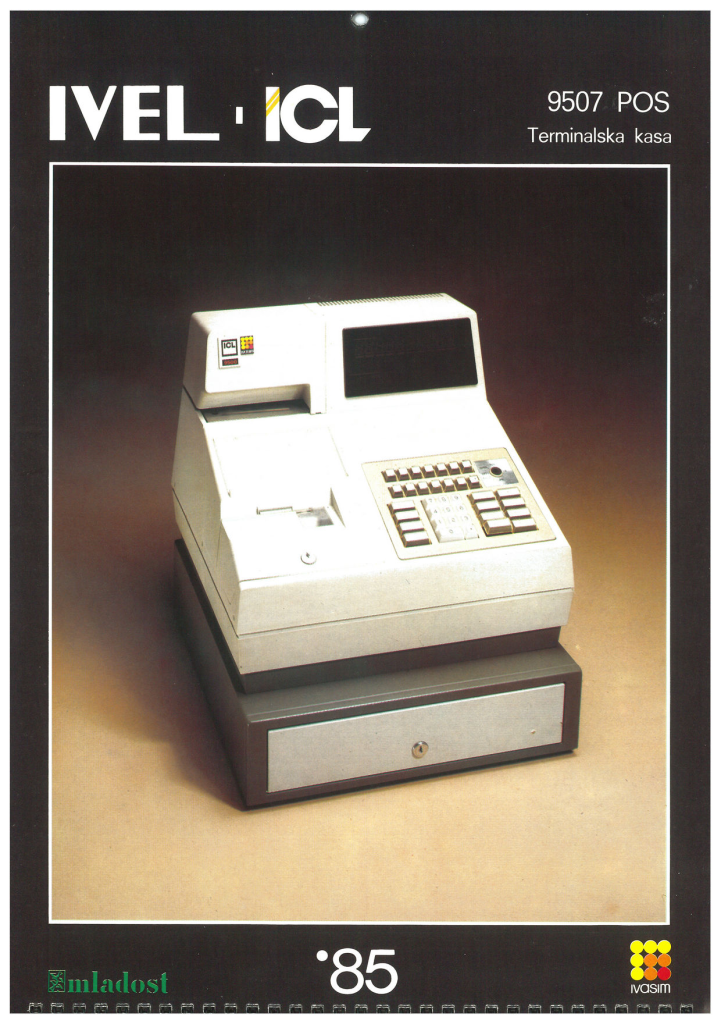
The ICL 9500 series of registers were somewhat modular in design. Field observations indicate customer pole displays were added to the registers well after the initial installation in the mid 1980s. The keyboard arrangement is also interesting to me, in that the Enter key isn’t a double height or double wide key, but rather just a raised key to the right of the bottom row of the number pad. The printers appear to be Epson printers using 44mm receipt tape.
Like the Singer predecessors, the ICL 9500s could be adapted to work with a variety of back-end systems. Back in this era, point of sale systems tended to store and forward data to other mainframe systems; there are plenty of examples where NCR cash registers in the early 1980s were supported by IBM Series/1 installations. While manufacturers preferred they used their “complete package”, there were other options.
In the latter half of the 1980s, the CIO of Kmart in the United States was focused on solving point of sale issues in the American stores. After a couple of failed attempts through Kmart U.S.’s work with IBM and NCR, the CIO and team worked with a variety of vendors for a cohesive solution. Kmart in the states moved to point of sale and inventory software by Post Services International, or PSI, of North Carolina. While Kmart stores in states could have NCR, IBM, or Fujitsu registers at the checkouts, they all ran on the same software. It appears Kmart Canada was a little ahead of their American counterparts in the front end technology department, and worked with PSI to get the same software running on their ICL 9500 series cash registers.
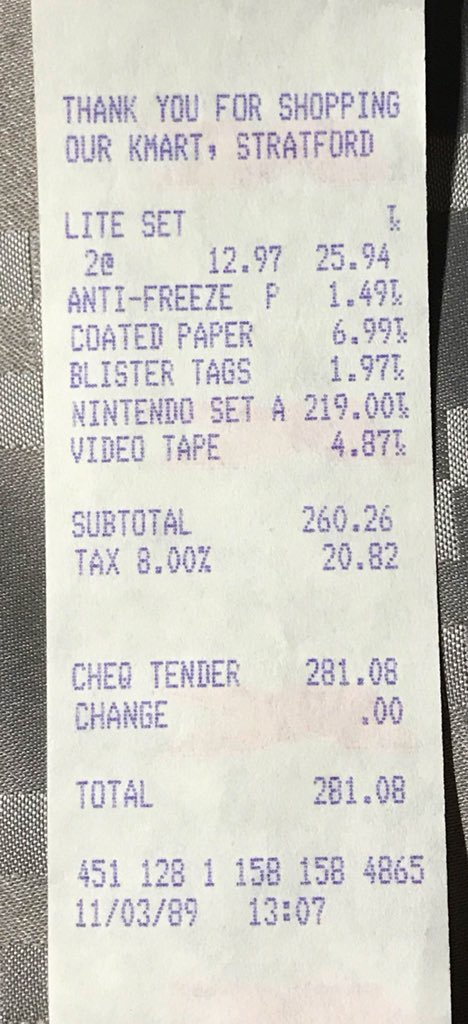
There are a couple of clues on the receipt pictured above that it’s a variant of the software running on the registers in the American Kmart stores of the time, primarily the “158 158” in the receipt data footer.
Like Kmart in the states, Kmart Canada was using satellite communications to connect their stores, warehouses, and offices together. The picture at the top of this entry is grabbed from a video of a CBC News Report about the satellite outage that caused computer outages throughout the chain. Unfortunately that video is no longer available.
Kmart Canada ran with the ICL 9500 series cash registers until the sale of the chain to Zellers in 1998. It was around that same time Kmart and other chains started planning for Y2K. Kmart would eventually move away from PSI to a modified version of IBM’s Supermarket Application (which was used at their Super Kmart stores). Zellers would introduce their mix of NCR and IBM systems to the stores purchased from Kmart Canada.
- 1 Computerworld, March 1978
bookmark_borderSinger-Friden, part 2.
As I’m doing more research on how long the Singer-Friden MDTS 908 900/9021 registers were around, I found a couple of shots of the grand opening of Sears in Casper, Wyoming. The store opened in 1982 and it appears installed the MDTS system in the new store.
I know Sears moved from the Singer-Friden registers to NCR 2152s in the 1980s. I was thinking it was around this time, but it must have been a little later in the decade. Of the electronic systems used by Sears, the NCR 2152 must have been around the shortest time, because in late 1991 CompuAdd in Texas designed cash registers for the Sears contract.
So, the Singer system was around for more than a decade (most likely with upgrades in the backend), the NCR system probably barely made it a decade, the CompuAdd systems were around for 10 years and the IBM SurePOS registers from the early 2000s are still around in the few remaining stores.
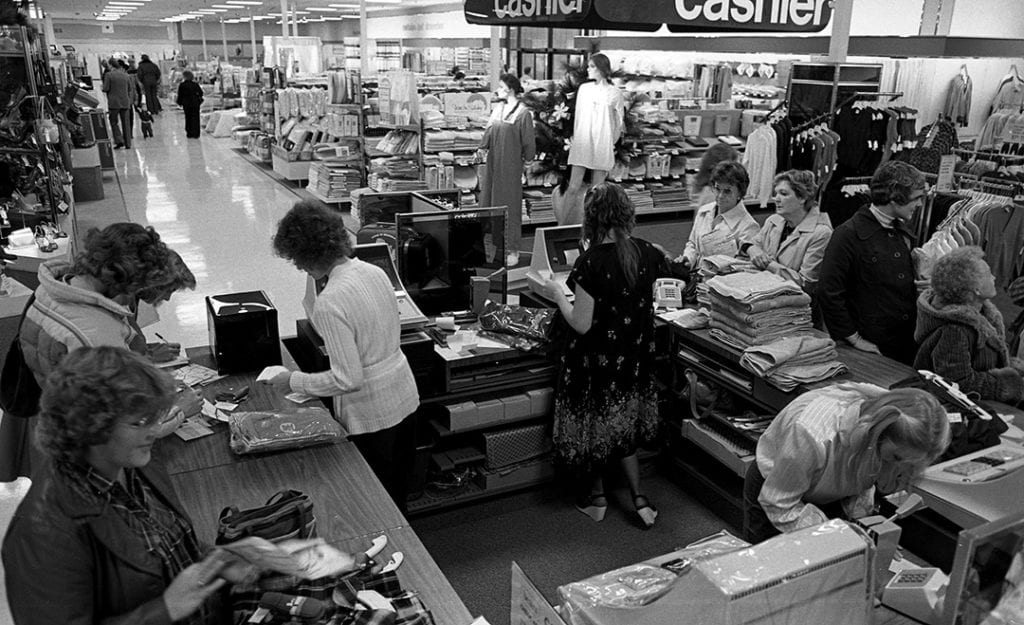
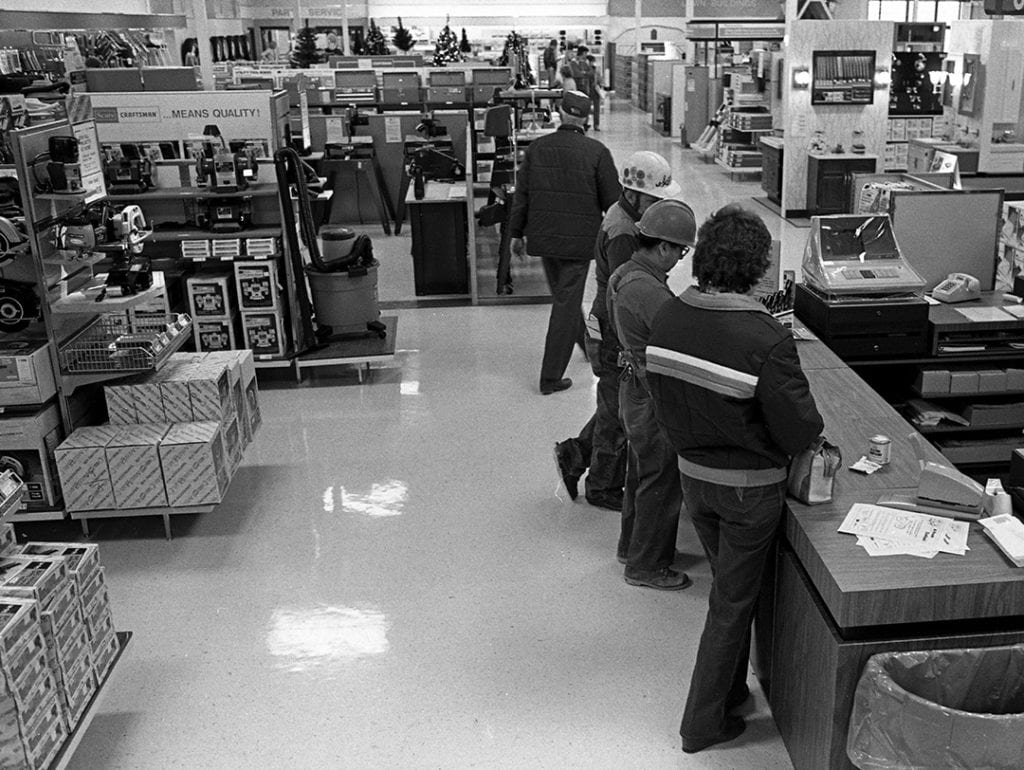
1 See comments around Sears using the Singer 900/902 registers, not 908 as originally reported.
bookmark_borderSinger-Friden MDTS Cash Register.
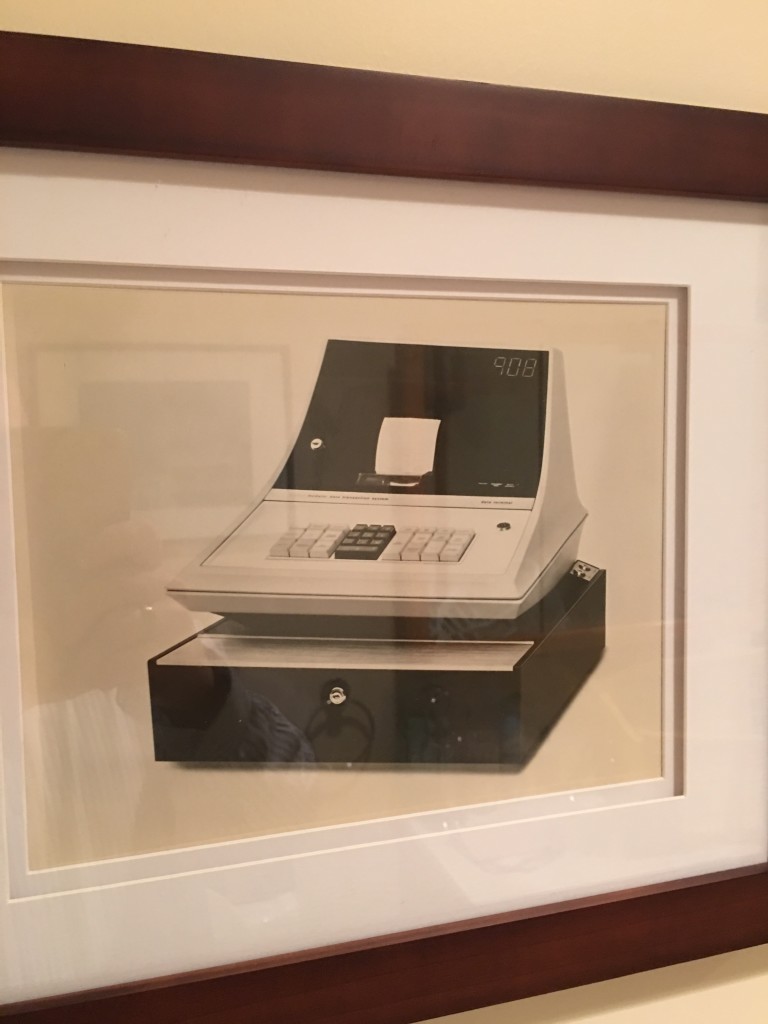
While surfing around on the internet I found some newish photos of the Singer-Friden 908 900 series Cash Register. The find made my heart leap because while the photos were on worthpoint.com, they indicated the source of the listing was eBay. Alas, I could not find a corresponding auction on eBay, because I would certainly go just about anywhere in the lower 48 states to pick up one of these cash registers. They’re in my “top five” of electronic point of sale system geekiness and probably one of the very first systems that caught my attention.
The Singer 908 ran on 2K of RAM. Developed in the late 1960s after Singer purchased Friden, cash registers of this series were typically found in Sears (900/902), JC Penney (925), and other department store chains. The numeric display showed only numbers; operator guidance was provided through the buttons lighting up in sequence of the program. The back-end system supporting this register was the Singer System Ten. The cash register terminal initiated all communication with the System Ten, communicating over a two-wire connected pair at 1200 baud. Many locations used store and forward tape units. All math operations were done locally at the register, the backend provided a credit authorization option and collected all the data from the terminal. Data was traditionally transmitted at the end of the day, but busier locations could schedule interval reports to the back office.
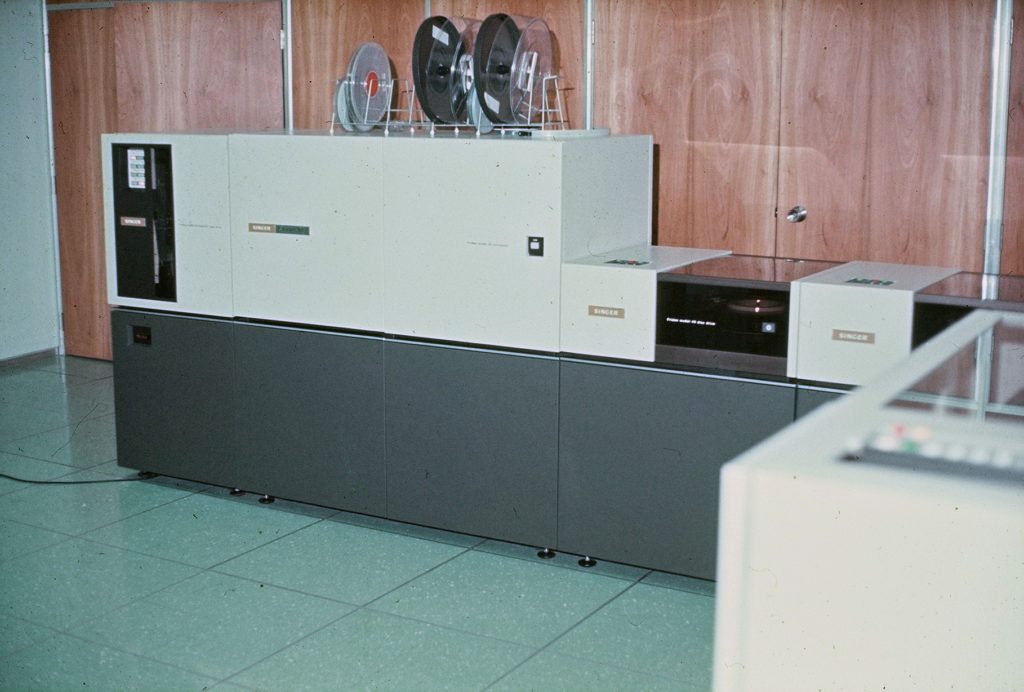
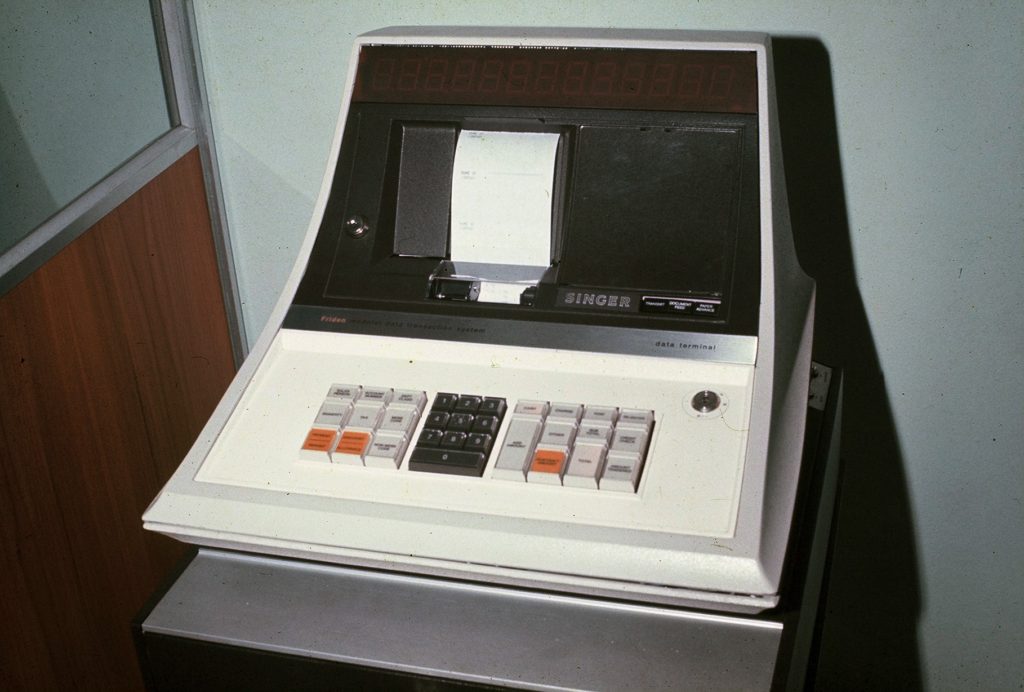
The Singer system was the first fully electronic point of sale system used by Sears. Curiously, I found a photo of a Walmart that also used the Singer system. The first generation of electronic cash registers at Walmart were made by several different manufacturers, NCR and Data Terminal Systems, and apparently, also Singer. The registers are easy to identify with their sleek, “sci-fi” design.
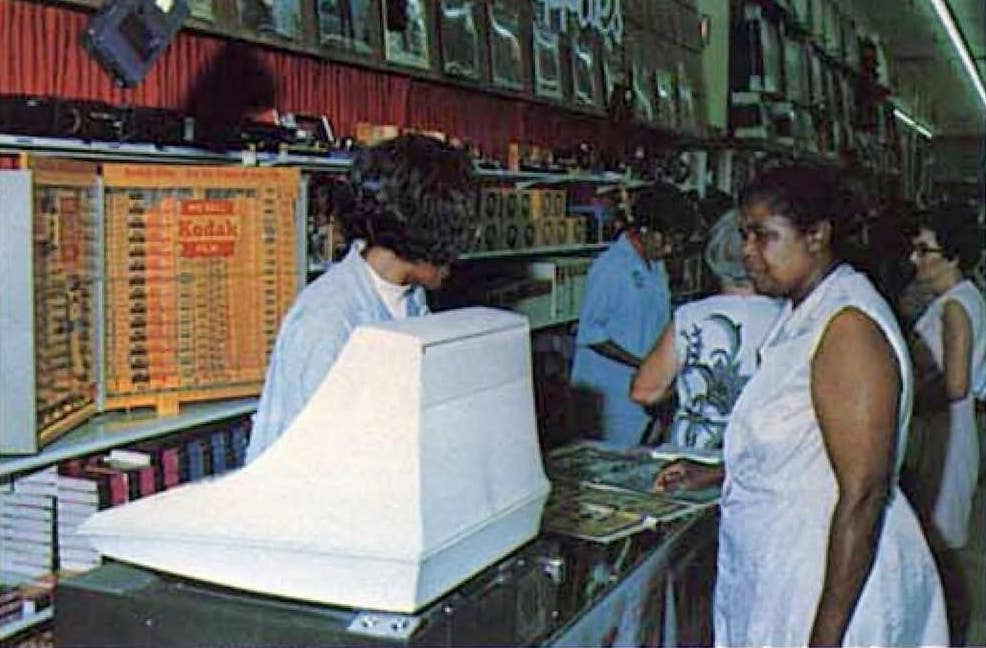
Notice the slight differences in the register above and the register at the bottom of this post. The picture above has a small “friden” logo and “data terminal” in lower case letters, the register at the bottom omits the “friden” logo and instead has “Data Terminal”. The register in the photo at the top of this post omits the “SINGER” name badge.
Here’s an example of a receipt from the Singer register at Sears. The registers were used by the chain into the early 1980s. In fact, I remember one of these registers still in the hardware department at the key duplication station in 1990 at our local Sears store.
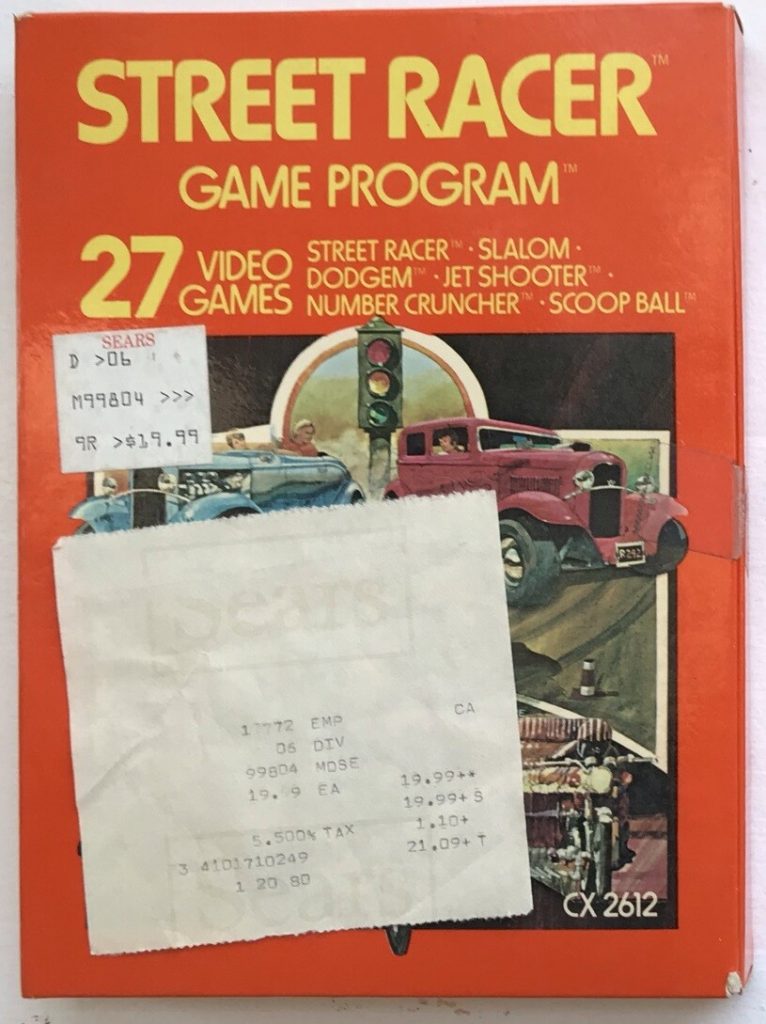
I have a marketing brochure that describes how the Modular Data Transaction System was designed to work.
MDTSHere’s some close up photos of the Singer cash register as found on worthpoint.com.
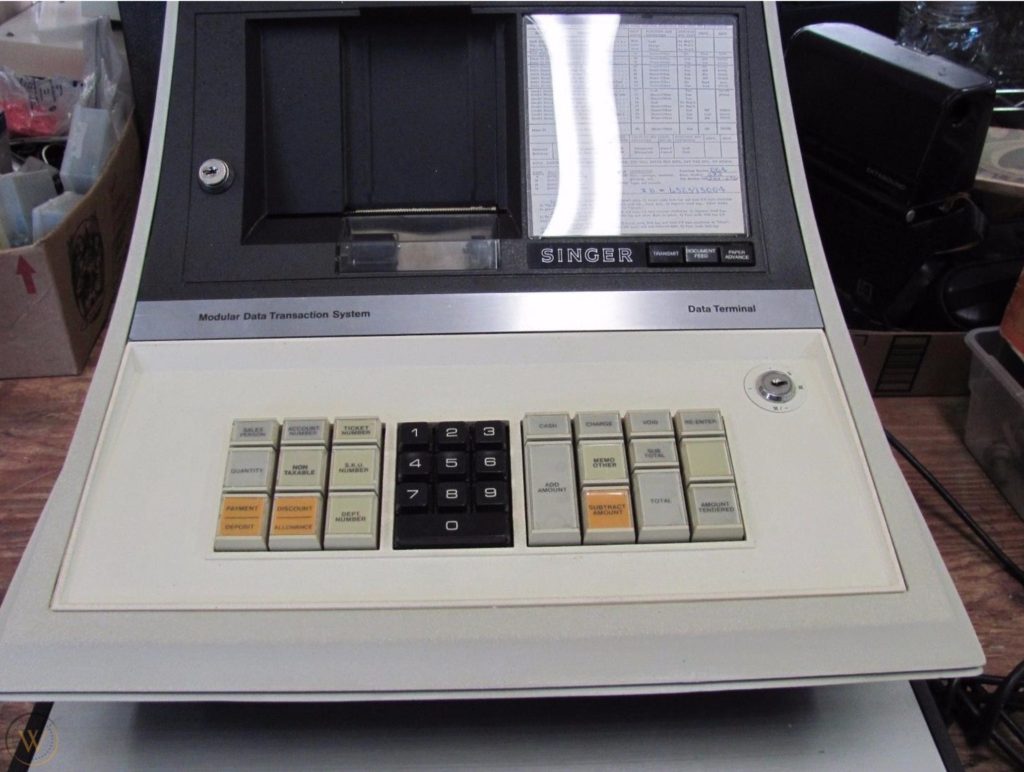
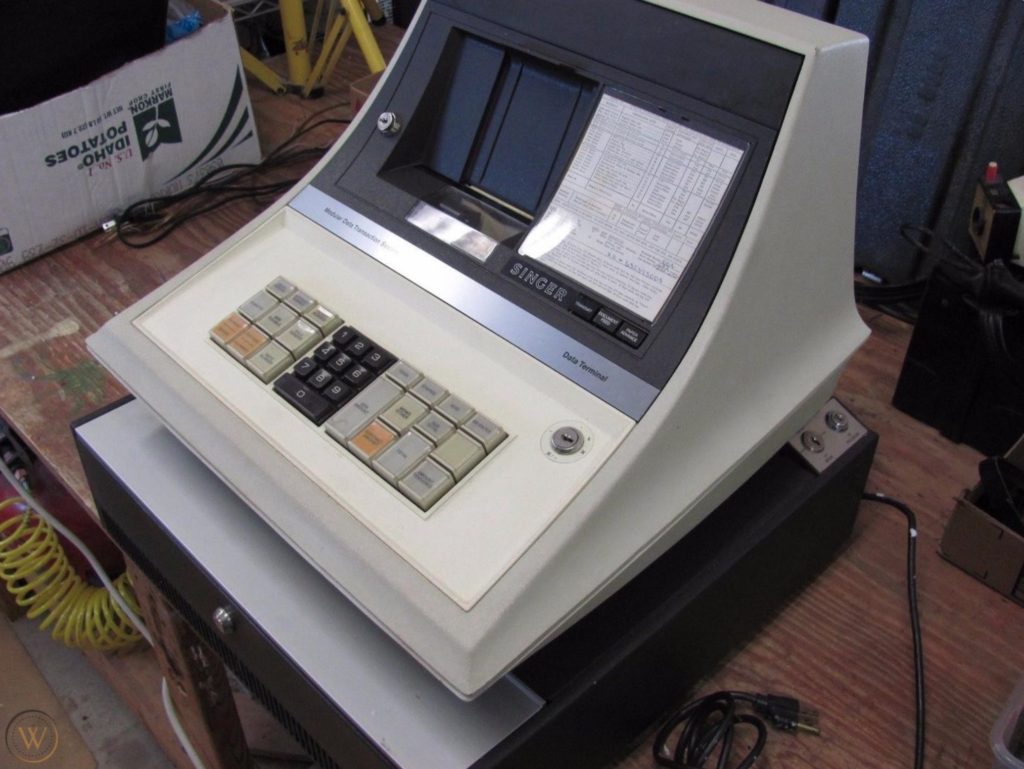
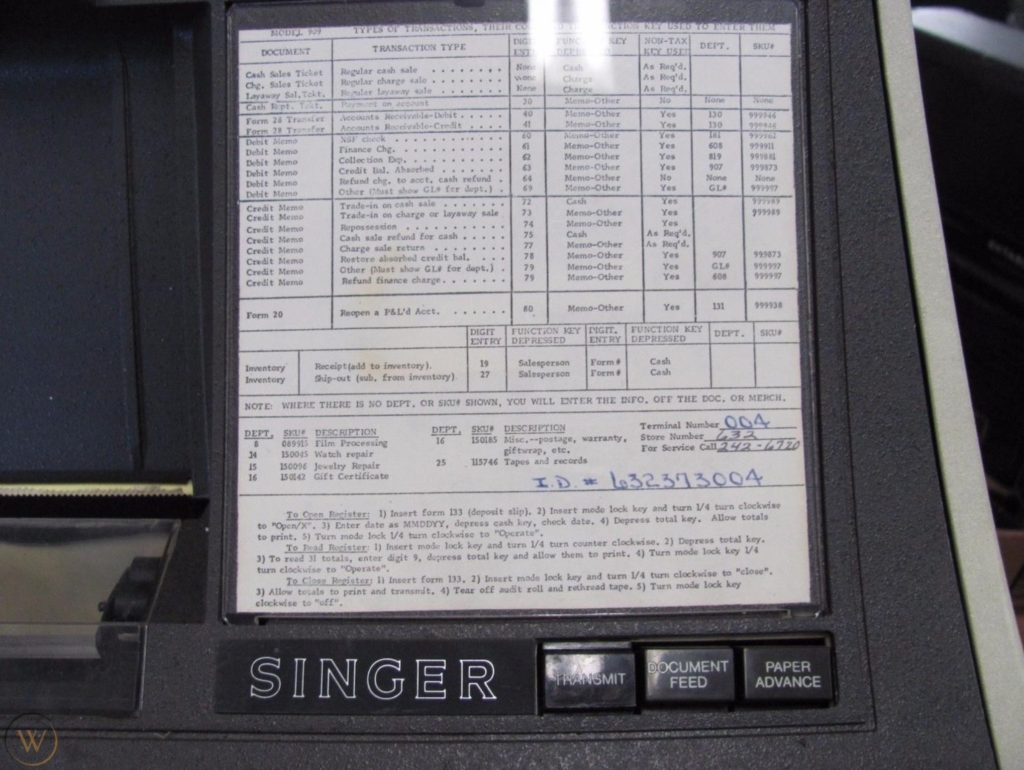
bookmark_borderQuality Markets.
When I lived in Western New York State, the Quality Markets supermarket chain was using Sweda cash registers with scanning. Depending on the age of the store, there were two versions of these cash registers. The earlier registers had impact printers that were rather loud but seemed to have the entire alphabet at their disposal when printing out the receipt. Newer stores had newer registers running what appeared the be the same software, but with dot-matrix printers handling the printing.
The cashier’s display was a basic guidance panel with numbers and lights, while the customer display was a full alphanumeric display showing the items being scanned. There were “flip cards” on the left side of the register that handled PLUs like produce and such, the “flip cards” triggering a switch the basically acted like a “shift key” so the same key could be used for multiple items. The card had a hand- or typewritten description of the item in question.
I don’t recall seeing the older Sweda systems elsewhere, but Shaw’s Markets in Massachusetts had the newer version with dot-matrix printers into the early 1990s.
I found this photo online of the older Sweda setup. I don’t think it’s a Quality Markets, but the registers are identical. I believe it’s the Sweda 80S system with two back office computers in the back made by Data General.
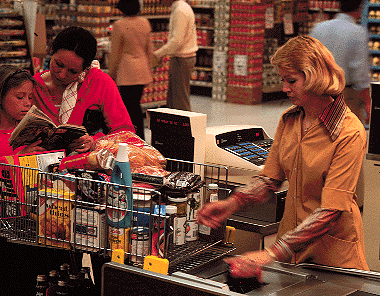
bookmark_borderSweda 800.
In the late 1950s through the mid 1980s, many store chains used the Sweda Model 46 Dataregister at the checkout. These registers were the usual mechanical cash registers of the time with an additional mechanism on the left hand side. This extra mechanism punched a ribbon tape that would later be fed into a mainframe off site; the ribbon tape typically contained inventory information.
In the early and mid 1970s electronic systems began replacing these mechanical counterparts. Companies such as Data Terminal Systems, IBM, Singer-Friden, TRW, and Pitney-Bowes introduced new electronic point of sale systems into the market. Mechanical cash register manufacturers such as NCR and Sweda also began introducing electronic systems to the space.
I mentioned in a previous entry that the local Two Guys store at Northern Lights Plaza north of Syracuse, New York had electronic cash registers of some sort and I was pretty sure they were made by Sweda. A photo of a standard Two Guys checkout gives us a small glimpse at these registers.
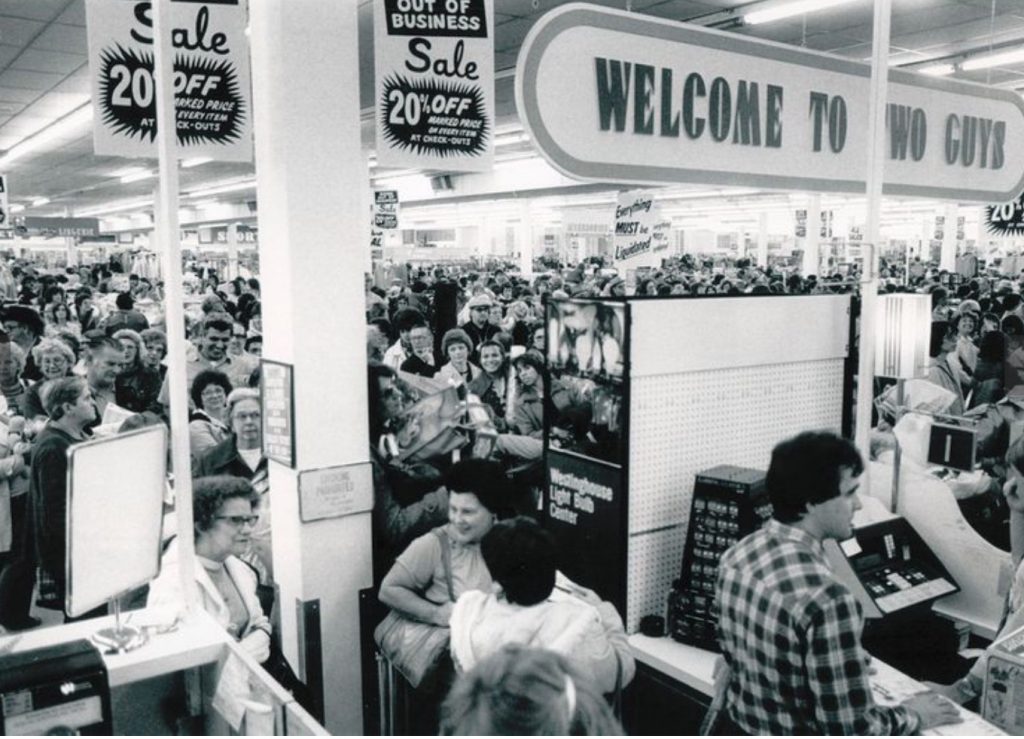
I can’t find a Two Guys receipt from this era, but I previously featured a Bradlees receipt from that time frame that had the same distinct font I remember from the Two Guys receipt.
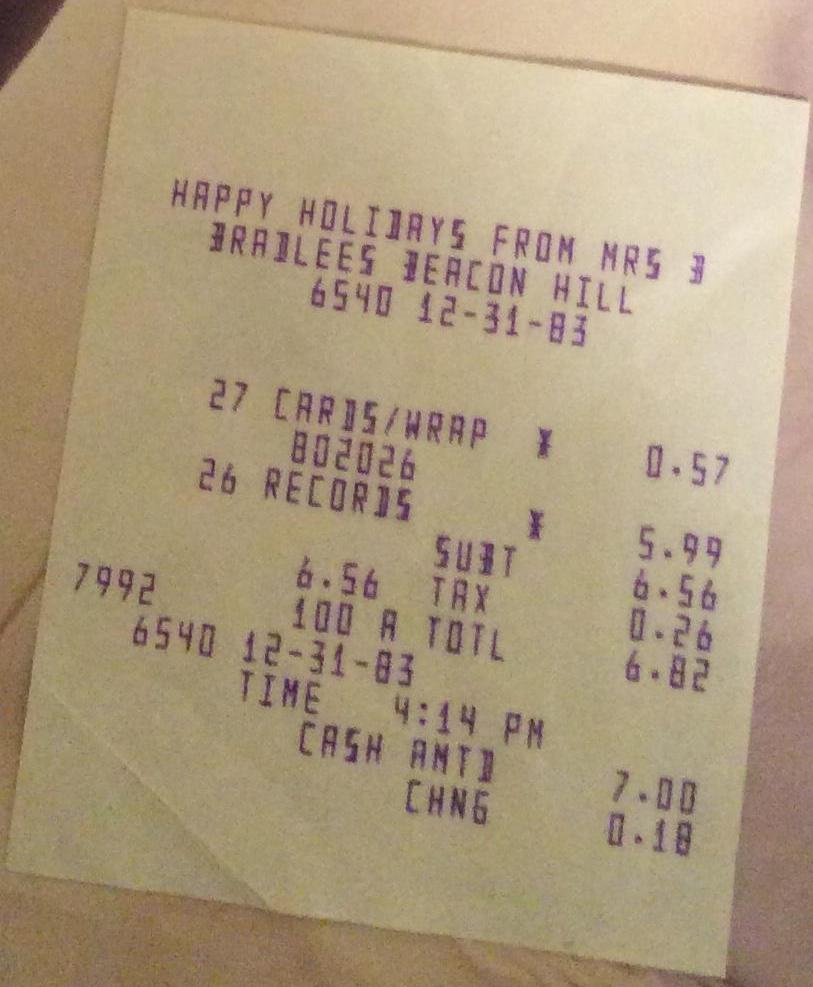
After some digging around on the Internet, I finally found an up close photo of one of these registers. The cash register is part of the “Sweda 800/80 system”. WT Grants apparently used this system before closing up shop in 1975. This is interesting to me, because the Two Guys at Northern Lights moved into a closed up WT Grants store at the same location.
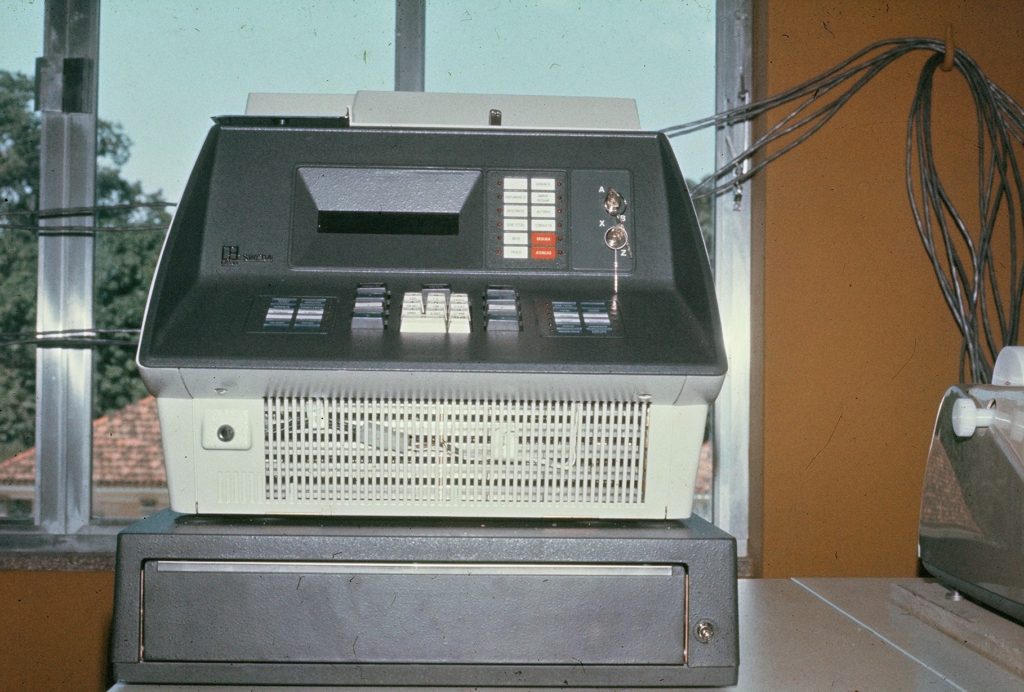
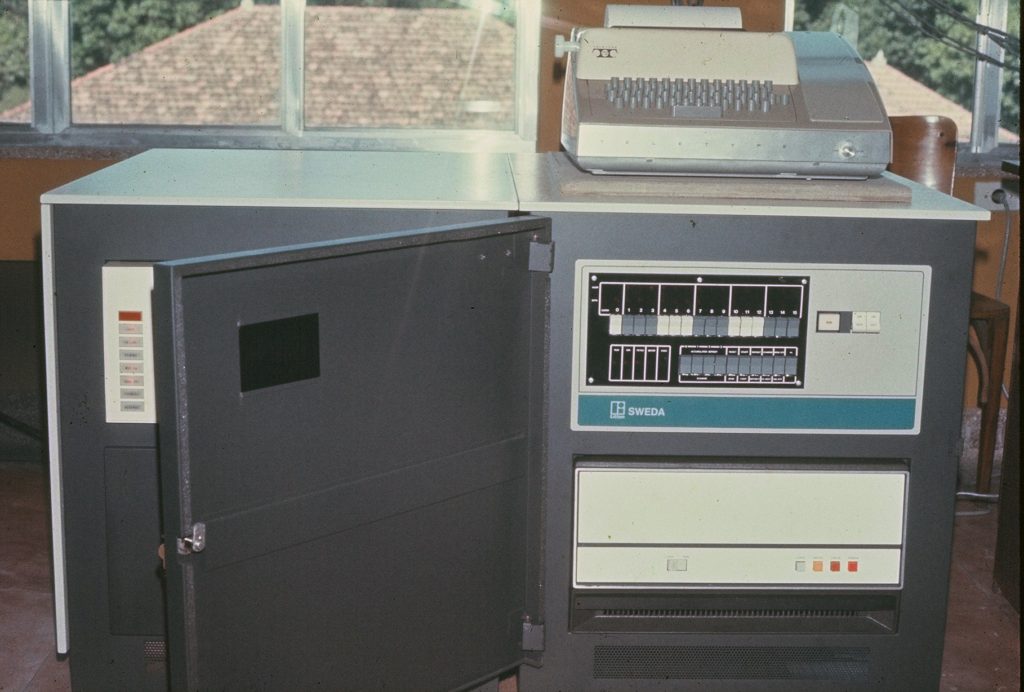
I’m still on the hunt for scans of old Two Guys receipts to confirm my research, as well as any other photos from the chain. I don’t know if Two Guys use of Sweda 800/80 registers was common to the chain, to the region, or to a particular store. At the time, many of the department store chains had varying register systems depending on region or location.
bookmark_borderSweda 76.
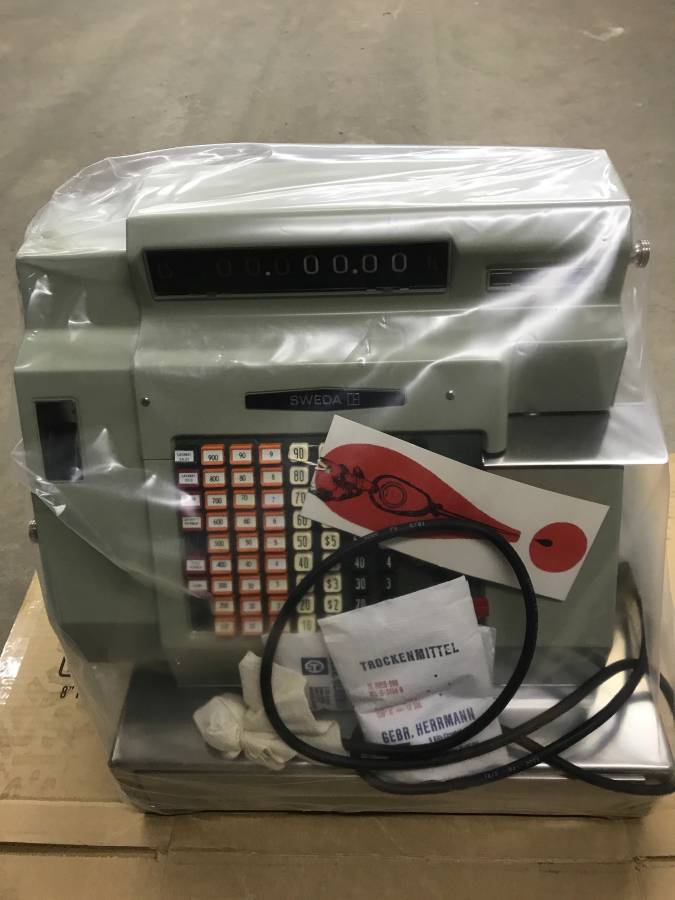
I found a listing for this Sweda 76 on Craigslist. It’s currently for sale in the Denver area. It’s never been used and was pulled for its original box for these photos.
I know this model and features from identical registers at Ames Department Stores’ service desks before the chain converted to the IBM 3680 Programmable Store System in the early 1980s. I can’t make out all the buttons in the left hand column, but the top two refer to layaways, and the bottom two (in the “4” and “3” row) are for inventory purposes. The features on this Sweda 76, and similar features on the Sweda 46, were used for inventory tracking purposes. The mechanism on the very left is for a punch tape that was removed and sent to a main office for routine scanning into a mainframe. The two inventory buttons are for “double pass” items. The cashier would enter two sets of numbers when ringing up these “double pass” items, usually in softlines. First pass would be an inventory number and the second pass would be the department or class along with the price. At least that’s the way Ames did it.
I suspect the other two buttons are related to refunds and other service desk functions. At the time, Ames handled layaways at the service desk. It would be later in the chain’s history that it would be moved to the back of the store with its own counter.
bookmark_borderIBM 5260 Retail Solution.
I stumbled across this video on YouTube from the Hagley Museum and Library channel. It is a very informative video on the IBM 5260 Retail Solution from the late 1970s and early 1980s.
A couple of interesting things about the cash register of this retail solution:
- The cashier prompts are actually a “rolling” tape with the appropriate prompt displayed through a window
- The keyboard was not conducive to touch-style entry. The chicklet keyboard required a firm touch and the keys were oddly sized
- The reason for the chicklet keyboard was the paper overlays used for programming the cash register
- Multiple registers could be networked together
- Data was stored on 8-inch floppy disks, much like the IBM 3684 from around the same era
I had the opportunity to work on one of these registers for a mall photo shop in the 1991 or 1992. By that time the cash register was pretty beat up but still worked reliably. The new owner of the store needed assistance in learning how the register worked and what his upgrade paths were. Providing this information was a lot of fun for me, though I was learning about the register along the way as well. The majority of my IBM point of sale experience, up to that point, had been writing user exits on the IBM 4680 series of registers as a contract programmer.
Enjoy the video!
